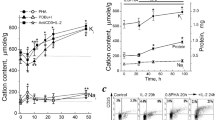Summary
RPMI 1788 lymphocytes growtn in semi-suspension culture proliferate as separate cells and in clumps. The addition of 10−3 m dibutyryl cyclic AMP (Bu2cAMP) to the culture resulted in the attachment of the cells to the substratum and a subsequent conversion of a portion of the adherent cells to a fibroblast-like morphology. Growth of the adherent cells proceeded at nearly the same rate as that of the control cells. When the cells cultured in the presence of Bu2cAMP were periodically disturbed, they remained in suspension and under this condition a distinct inhibition of growth by Bu2cAMP was observed.
Cortisol at 10−5 m, a concentration having no effect on the proliferation of RPMI 1788 cells, when added to cells cultured in the presence of Bu2cAMP, prevented cell attachment, caused detachment of already adherent cells and thereby brought about the Bu2cAMP-mediated inhibition of growth in suspension. At a higher concentration (10−4 m), cortisol alone reduced the growth rate of RPMI 1788 lymphocytes. Under the combined effects of 10−4 m cortisol and 10−3 m Bu2cAMP, the proliferation and viability of cells in suspension were significantly lower than in the presence of either agent alone.
Similar content being viewed by others
References
Sheppard, J. R. 1972. Difference in the cyclic adenosine 3′,5′-monophosphate levels in normal and transformed cells. Nature New Biol. 236: 14–16.
Grimes, W. J., and J. L. Schroeder. 1973. Dibutyryl cyclic adenosine 3′5′ monophosphate, sugar transport, and regulation of cell divisions in normal and transformed cells. J. Cell Biol. 56: 487–491.
Teel, R. W., and R. G. Hall. 1973. Effect of dibutyryl cyclic AMP on the restoration of contact inhibition in tumor cells and its relationship to cell density and the cell cycle. Exp. Cell Res. 76: 390–394.
Wright, J. A., H. Ceri, and W. H. Lewis. 1973. Similar growth of Chinese hamster cells in the presence of phenethyl alcohol or dibutyryl cyclic AMP. Nature New Biol. 244: 84–86.
Thomas, D. B., G. Medley, and C. A. Lingwood. 1973. Growth inhibition of murine tumor cells,in vitro, by puromycin, (6N)O2′-dibutyryl 3′,5′-adenosine monophosphate or adenosine. J. Cell Biol. 57: 397–405.
Kurth, R., and H. Bauer. 1973. Influence of dibutyryl cyclic AMP and theophylline on cell surface antigens on oncornavirus transformed cells. Nature New Biol. 243: 243–245.
Johnson, G. S., and I. Pastan, 1972. Role of 3′,5′-adenosine monophosphate in regulation of morphology and growth of transformed and normal fibroblasts. J. Natl. Cancer Inst. 48: 1377–1387.
Puck, T. T., C. A. Waldren, and A. W. Hsie. 1972. Membrane dynamics in the action of dibutyryl adenosine 3′,5′-cyclic monophosphate and testosterone on mammalian cells. Proc. Natl. Acad. Sci. U.S.A. 69: 1943–1947.
Hauschka, P. V., L. R. Everhart, and W. Rubin. 1972. Alteration of nucleotide transport of Chinese hamster cells by dibutyryl adenosine 3′,5′-cyclic monophosphate. Proc. Natl. Acad. Sci. U.S.A. 69: 3542–3546.
Patterson, D., and C. A. Waldren. 1973. The effect of inhibitors of RNA and protein synthesis on dibutyryl cyclic AMP mediated morphological transformations of Chinese hamster ovary cellsin vitro. Biochem. Biophys. Res. Commun. 50: 566–573.
Johnson, G. S., and I. Pastan. 1972. Cyclic AMP increases the adhesion of fibroblasts to substratum. Nature New Biol. 236: 247–249.
Grinnell, F., M. Milan, and P. A. Srere. 1973. Cyclic AMP does not affect the rate at which cells attach to a substratum. Nature New Biol. 241: 82–83.
Puck, T. T. 1973. In: J. Schultz and H. G. Gratzner (Eds.),Role of Cyclic Nucleotides in Carcinogenesis. Academic Press, London, pp. 283–302.
Daniel, V., G. Litwack, and G. M. Tomkins. 1973. Induction of cytolysis of cultural lymphoma cells by adenosine 3′,5′-cyclic monophosphate and the isolation of resistant variants. Proc. Natl. Acad. Sci. U.S.A. 70: 76–79.
Ballard, P. L., and G. M. Tomkins. 1969. Hormone induced modification of the cell surface. Nature 224: 344–345.
Sheppard, J. R. 1971. Restoration of contact-inhibited growth to transformed cells by dibutyryl adenosine 3′,5′-cyclic monophosphate. Proc. Natl. Acad. Sci. U.S.A. 68: 1316–1320.
Author information
Authors and Affiliations
Rights and permissions
About this article
Cite this article
Smith, S.W., Werthamer, S. & Artman, M. Differential effects of dibutyryl cyclic AMP on the growth and morphology of an established human lymphocyte line. In Vitro 10, 225–229 (1974). https://doi.org/10.1007/BF02615236
Issue Date:
DOI: https://doi.org/10.1007/BF02615236




